
So, you're planning an epic multi-country trip across Africa? That's awesome! But let's be real: trying to schedule four wildly different nations—from Morocco's sun-baked desert to Congo's humid rainforest is a major planning headache. The "perfect" time really comes down to what you want to prioritize. Are you focused on dodging the massive tourist crowds, hunting for the best budget deals, or trying to hit the absolute sweet spot for a specific adventure, like trekking gorillas or summiting a mountain?This 2025 guide will help you nail the timing for Morocco, Cameroon, the Congos, and Egypt, making your grand tour as smooth as possible.
Why April and October Win for the Combo Trip
If you're determined to fit all four of these amazing countries into one itinerary, the shoulder months of April and October are your best friends. They offer the greatest climatic compromise across the entire route:

Morocco & Egypt: We're talking ideal T-shirt weather! Temperatures are warm but comfortable (around 20-28°C) in major sightseeing cities like Marrakech, Cairo, and Luxor. You can explore those ancient sites without totally melting in the summer heat.
Coastal Morocco: The Atlantic breeze is lovely for seaside chill time in places like Essaouira and Agadir, right before the big summer crowds arrive.
The Nile Valley: The conditions are perfect for a relaxing Nile River cruise. You avoid the extreme heat of mid-summer and the peak tourist hustle of mid-winter.
Cameroon & Congo: These are transitional periods. The landscapes are lush and green, but you'll often find the heaviest downpours (especially in Cameroon's south) are either wrapping up or haven't fully kicked off yet.
You Can Have Morocco Desert, Coast, or Mountain?
Morocco is a study in contrasts, which means the "best" time to visit changes dramatically depending on whether you're by the Atlantic, deep in the Sahara, or high in the mountains.
Is It Too Hot? (A Reality Check for June & July)
For most inland city exploring, the short answer is yes, it's brutal. Summer months can be savage, but there are a few exceptions:
Inland Regions (Marrakech, Fes): Temperatures often soar past $35^\circ C$ ($95^\circ F$), turning sightseeing into a sweaty challenge. This is the low season for these areas, meaning fewer crowds and way better hotel deals if you can handle the heat.
Coastal Escapes (Essaouira, Tangier): These spots stay relatively cool and mild thanks to the ocean's influence. July and August are actually perfect for a proper Moroccan beach holiday.
Desert Treks: Seriously, skip the Sahara in mid-summer (July and August). The thermometer regularly blasts past $40^\circ C$—it's just too risky.
When to Avoid the Ice and the Fryer Trekking the High Atlas?
To comfortably and safely hike big peaks like Mount Toubkal, you need to navigate around the temperature extremes:
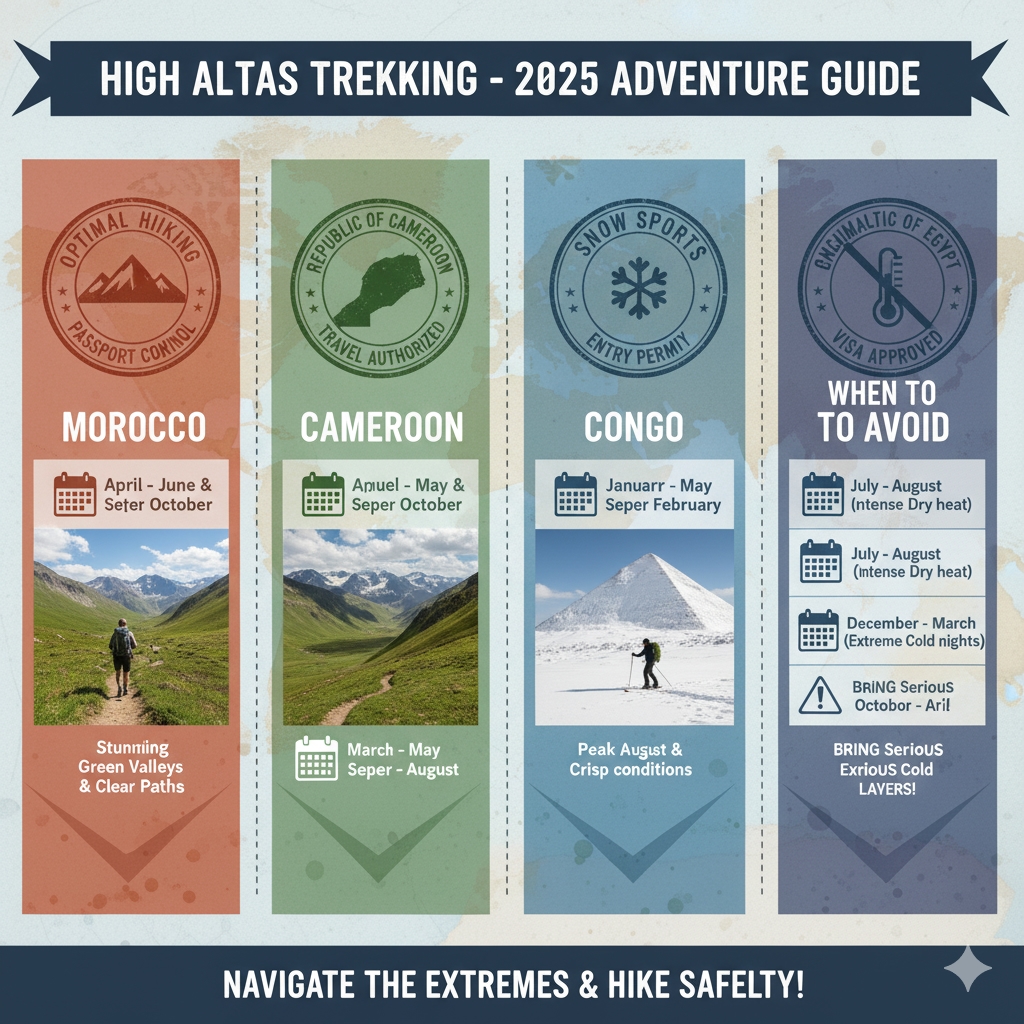
Optimal Hiking: Plan for April to June (before the intense dry heat) and September to October (once the summer furnace has cooled). You'll be rewarded with stunning green valleys fed by melting snow and clear paths.
Snow Sports: January and February are your peak months if you're after snow activities or prefer cool, crisp conditions for lower-elevation walks.
Winter Travel Note: Days in the mountains and desert are manageable, but trust me, nights are extremely cold. Bring serious layers!
Which part of Egypt is the hottest?
The sheer, overwhelming heat of Best Time to Visit Egypt is what dictates its tourist seasons more than anything else.
When to Book That Nile River Cruise in 2025
A Nile cruise connecting Luxor and Aswan is a highlight, and the best time is when you can actually enjoy the deck:

Optimal Cruise Window: October to April. The weather is cool and pleasant—you'll rarely see daytime highs over $25^\circ C$ in December/January.
Best Value Cruise: Try cruising in October or November. You get gorgeous weather before the massive Christmas and New Year's peak, balancing comfort and cost perfectly.
Avoid: Late May through August. Temperatures in Upper Egypt (where the big temples are) hit $40^\circ C+$ daily, making temple excursions almost unbearable.
Red Sea Diving Hurghada and Sharm El Sheikh Year-Round
If diving or beach time is your main focus, the Red Sea is great all year, but the details change:
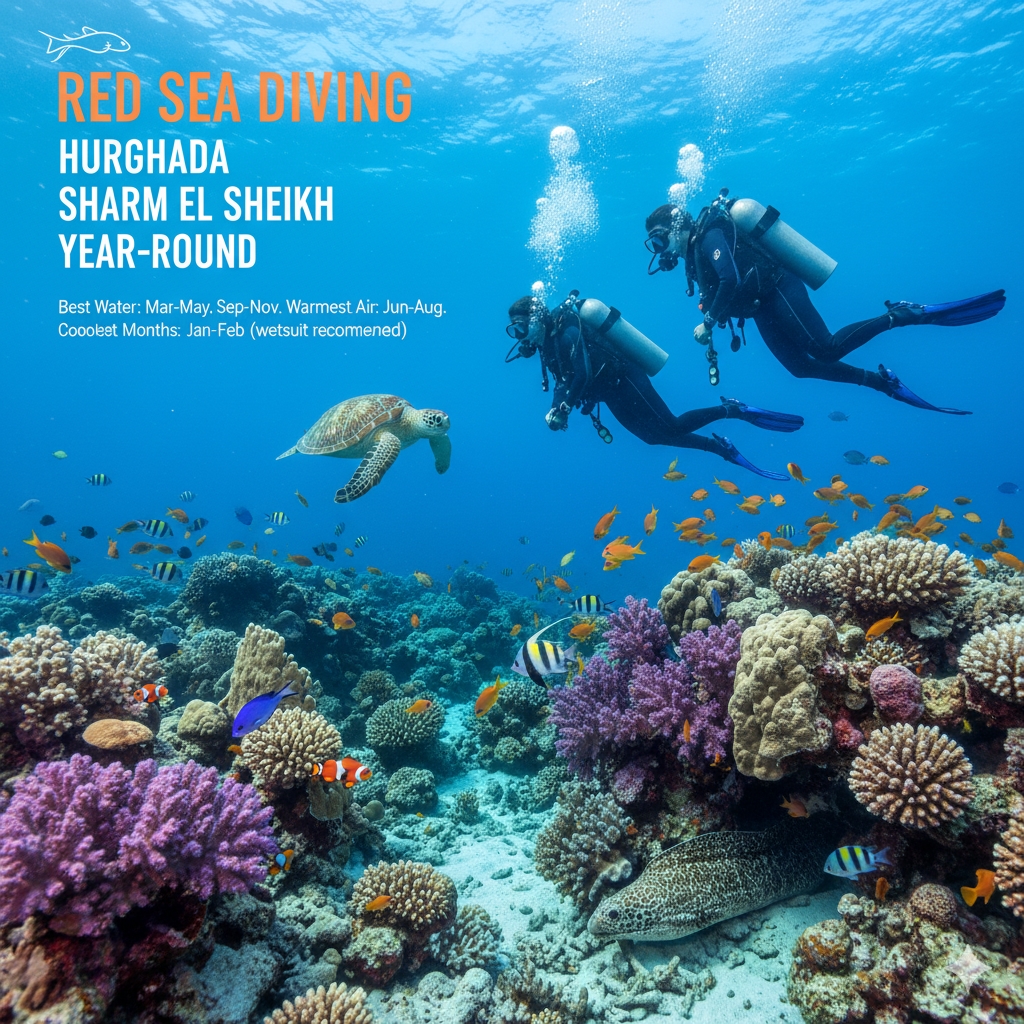
Best Water Temperatures: March through May and September through November. The sea is bathwater warm, and the air isn't yet scorching hot.
Warmest Air Temperature: June to August. Ideal for tanning, but expect extreme midday heat when you're out of the water.
Coolest Months: January and February. The water is still swimmable (around $21^\circ C - 23^\circ C$), but you'll probably want a wetsuit, and you'll definitely need a jacket for the evenings.
Cameroon Hiking, Safaris, and Tropical Downpours
Top destinations in Cameroon , often nicknamed "Africa in miniature," basically have two big seasons: the dry north and the highly humid, tropical south.
Cameroon's Safari Sweet Spot Hunting Wildlife in the Dry Season (November–February)
The dry season is generally considered the best time for tourism, especially for spotting wildlife and ensuring access:
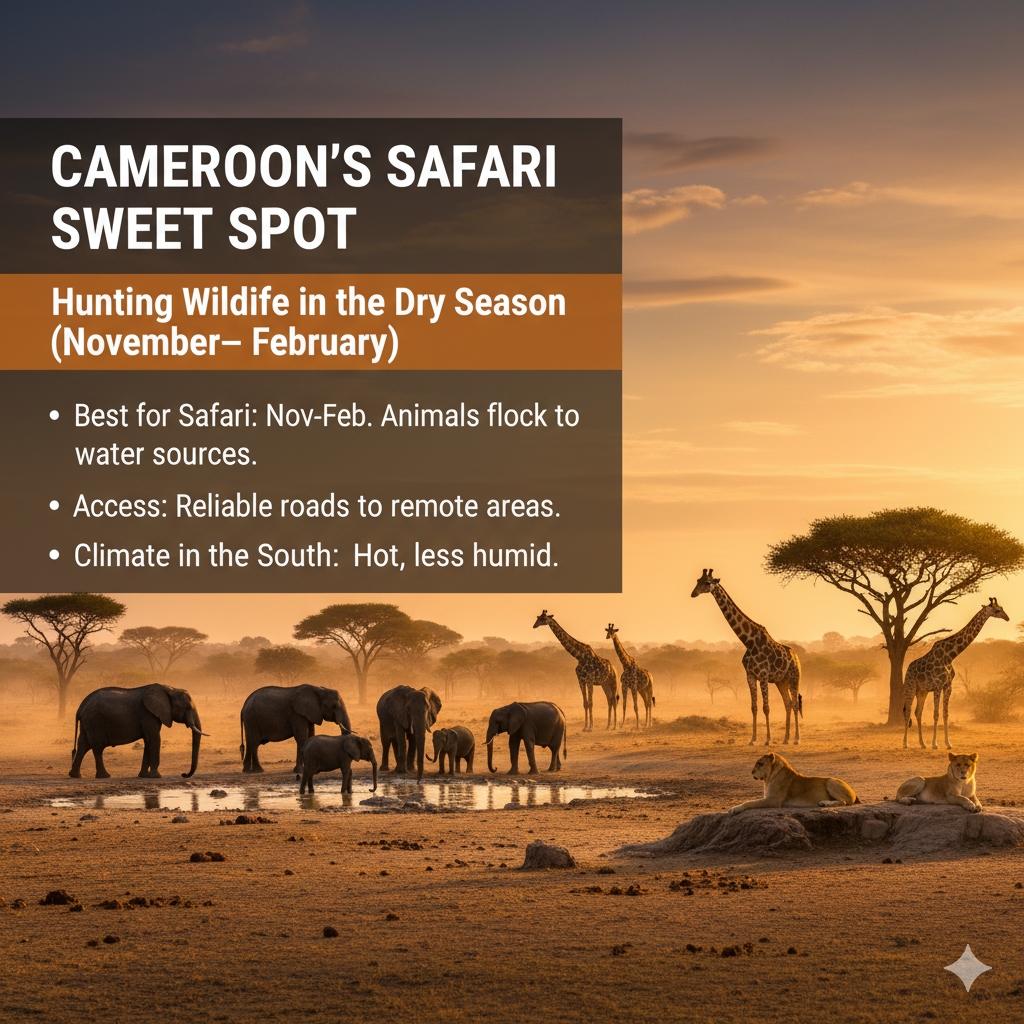
Best for Safari: November to February. Animals flock to the diminished water sources, making them super visible, particularly in northern parks like Waza.
Access: Roads are most reliable during this time—essential for getting to remote areas safely and simply.
Climate in the South: Coastal cities (Douala, Limbe) remain hot but are way less sticky and humid than during the rainy months.
Tackling Mount Cameroon Timing Your Summit Climb
Mount Cameroon is famously one of the wettest places in Africa, so timing your hike is critical:
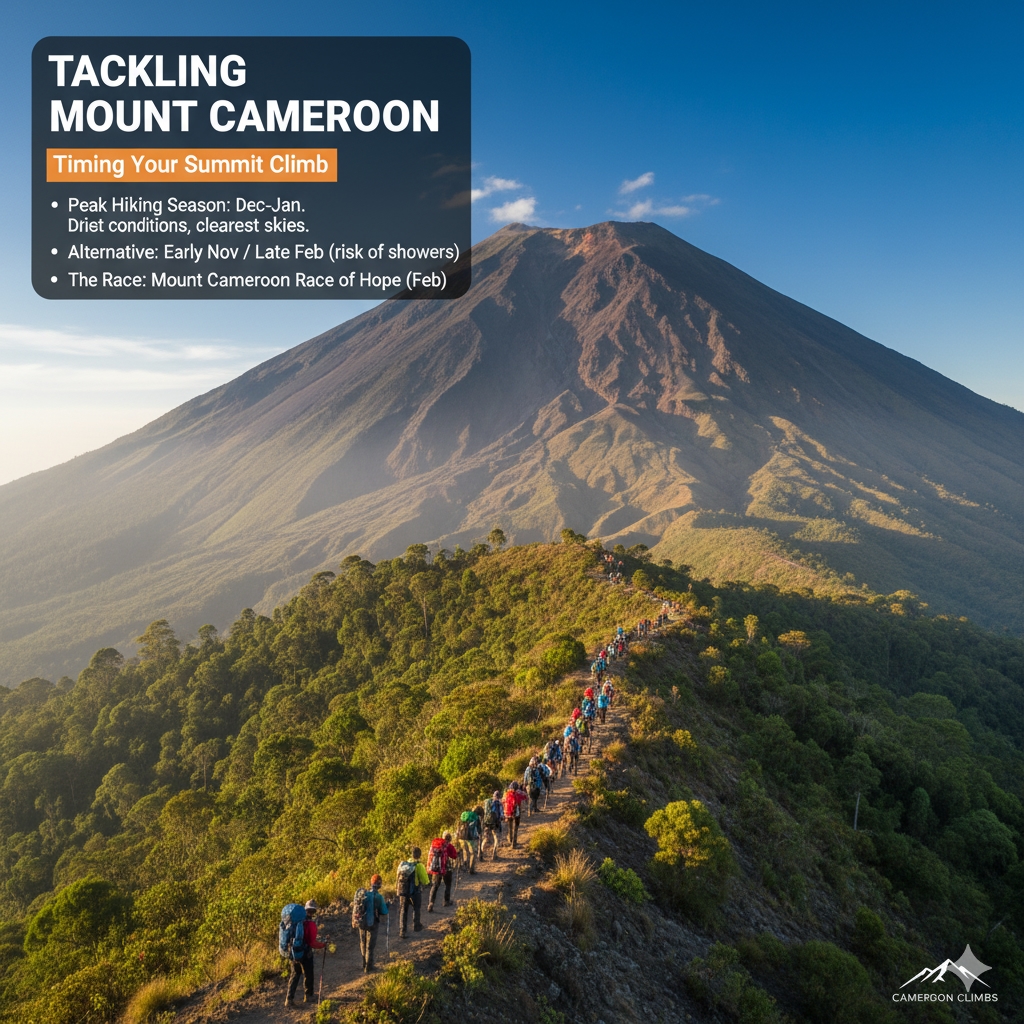
Peak Hiking Season: December and January. These months offer the driest conditions and the clearest skies for that incredible trek. The wider dry season runs from November to March.
Alternative Window: Early November or late February can work, but you're rolling the dice on increased humidity or light showers.
The Race: The Mount Cameroon Race of Hope (usually in February) is a popular, high-energy cultural event to try and plan your trip around!
Navigating the Rainy Season Green Views and Cheap Deals
Don't totally write off the long rainy season (March/April to October), especially if you love nature and a bargain:
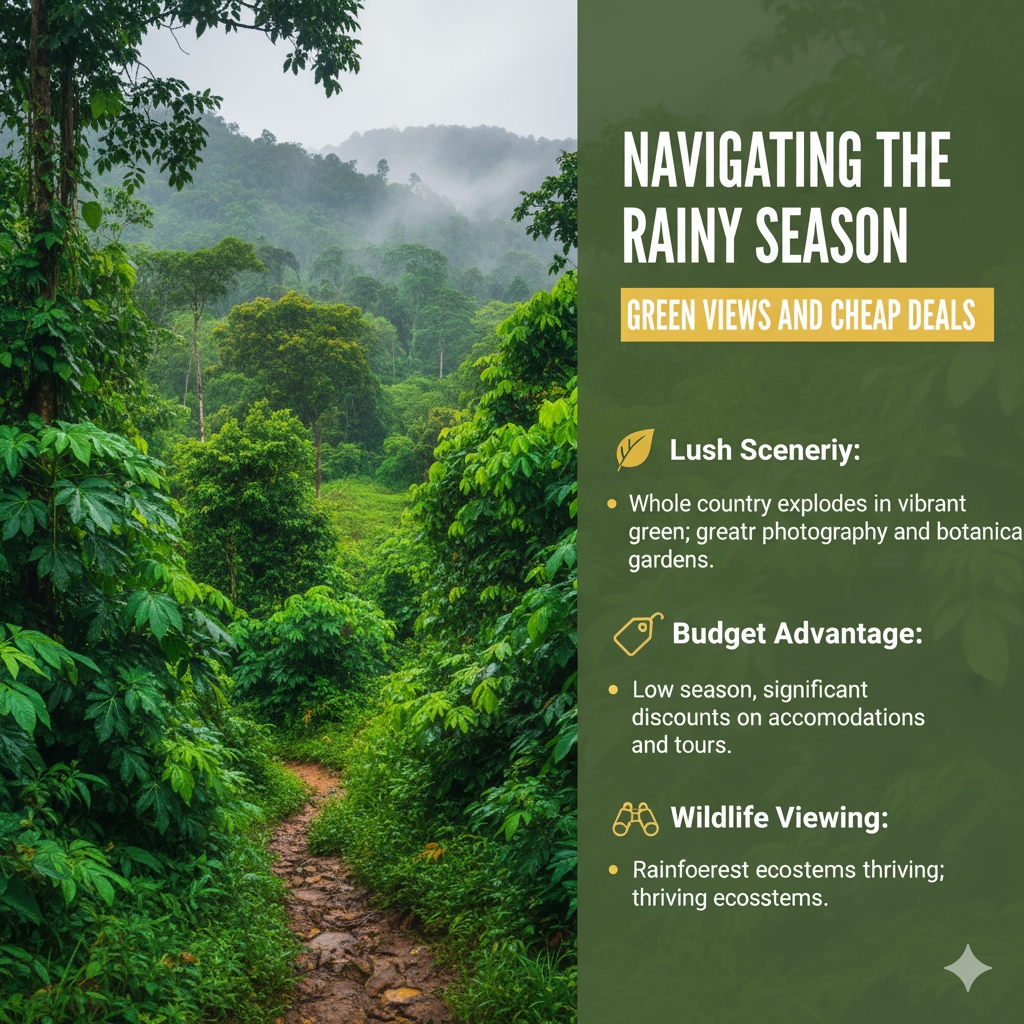
Lush Scenery: The whole country explodes in vibrant green—it's gorgeous for photography and botanical garden visits (hello, Limbe).
Budget Advantage: This is the low season, so you can often snag significant discounts on accommodations and tours.
Wildlife Viewing: Visibility for large animals is lower, but the rainforest ecosystems are absolutely thriving.
Quick Cameroon Trip Decision Form
Use this checklist to quickly determine your best travel dates for Cameroon based on your primary activities:
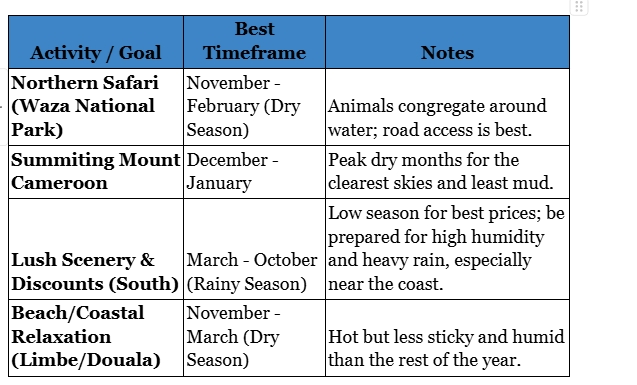
The Congos (RoC/DRC) Gorilla Trekking Strategies
When people talk about Top adventurous things to do in Congo, they're usually laser-focused on the rainforests of the Republic of the Congo (RoC) or the Democratic Republic of the Congo (DRC), specifically for lowland or mountain gorilla treks.
Is the Mud Worth the Savings Gorilla Permit Discounts?
Gorillas are homebodies and are visible all year, but the difficulty of the actual trek changes wildly by season:
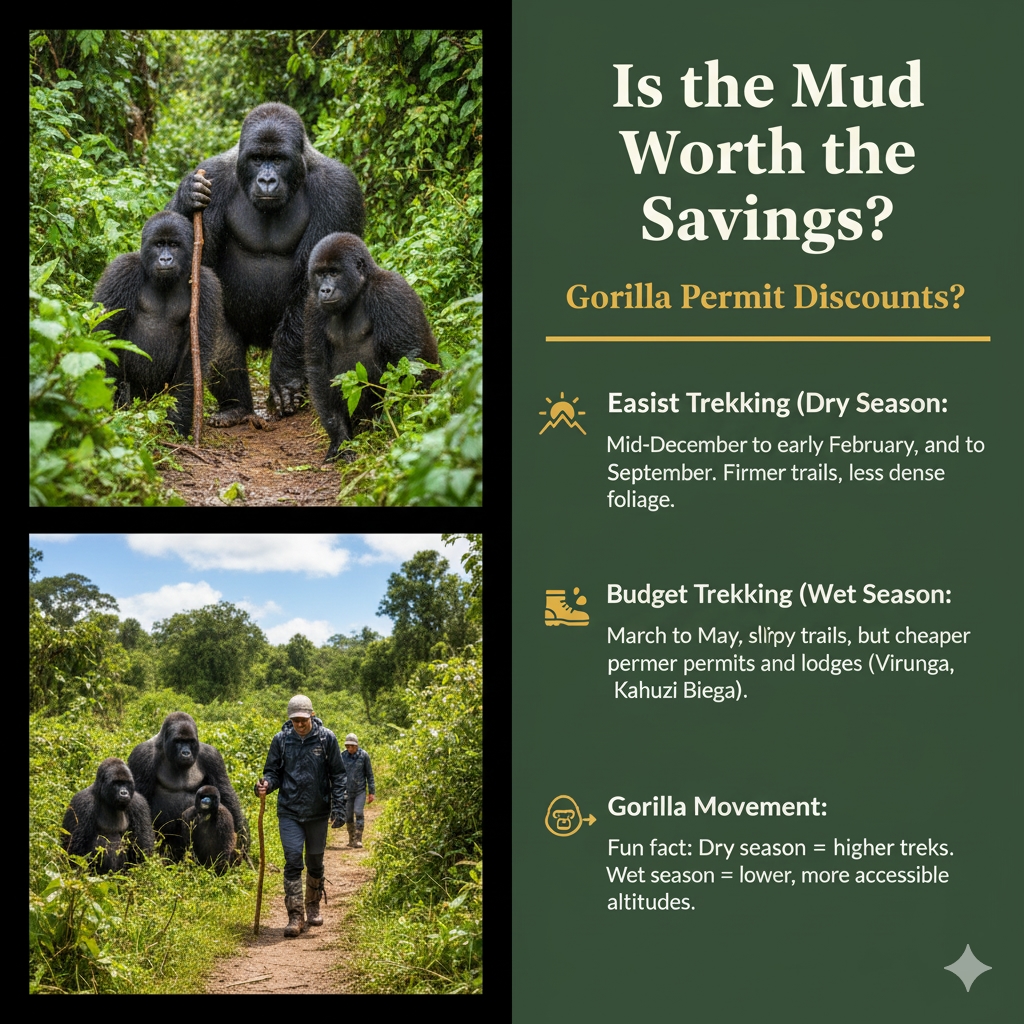
Easiest Trekking (Dry Season): Mid-December to early February, and June to September. The trails are firmer, and the thick jungle foliage is slightly less dense.
Budget Trekking (Wet Season): March to May, and November. Yes, the trails will be muddier and more slippery, but permits and lodge prices are often significantly cheaper in areas like Virunga and Kahuzi Biega (DRC).
Gorilla Movement: Fun fact: In the dry season, gorillas sometimes move higher up the mountains, leading to a longer trek. In the wet season, they often stay at lower, more accessible altitudes because food is abundant everywhere.
The Formal Stuff Visas and Document
Sorting out your Morocco visa requirements is critical for a smooth journey. Since requirements depend entirely on your passport, you must check the sources for your specific nationality before booking anything.
Quick Visa Details by Country (Tourist/Short-Stay)
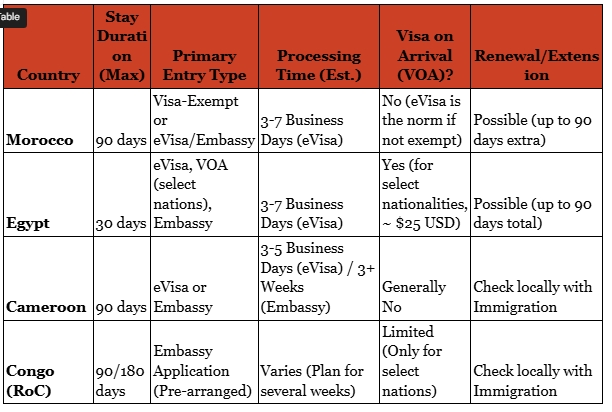
Your Quick Checklist Visa Document Requirement
This checklist is designed to help you quickly identify potential administrative blockers before you start the application process.
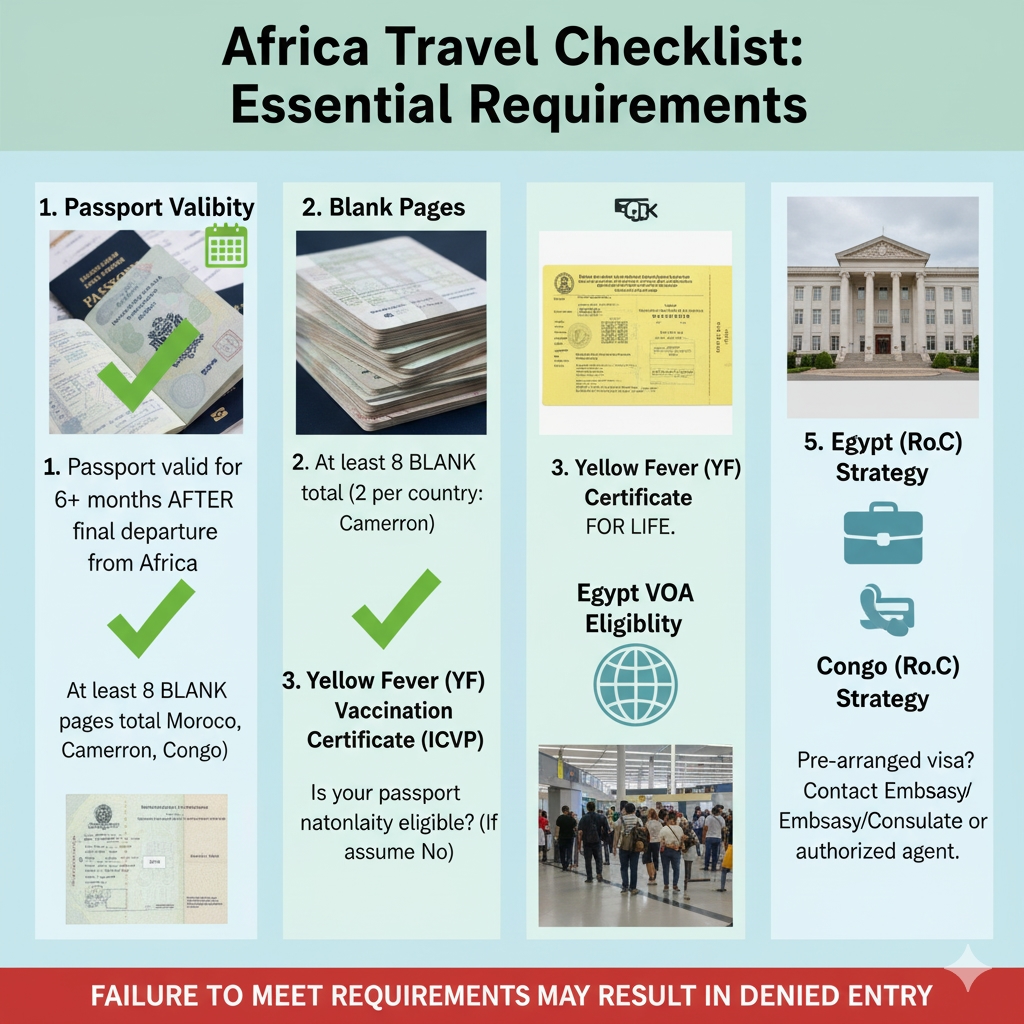
1.Passport Validity: Is your passport valid for at least 6 months after your final departure date from Africa?
2.Blank Pages: Do you have at least 8 blank pages total (2 per country: Morocco, Egypt, Cameroon, Congo)?
3.Yellow Fever (YF) Certificate: Do you possess a valid Yellow Fever Vaccination Certificate (ICVP) that is valid for life?
4.Egypt VOA Eligibility: Is your passport nationality eligible for an Egyptian Visa on Arrival (VOA)? (If unsure, assume No)
5.Congo (RoC) Strategy: Have you contacted the nearest Embassy/Consulate or an authorized visa agent for a pre-arranged visa?
How can I apply for the e-Visa Application?
The e-Visa process is pretty standard across Morocco, Egypt, and Cameroon. Just follow these steps:

Check Eligibility: Make sure your passport nationality is actually eligible for the e-Visa scheme on the country.
Gather Documents: Digitally prep your passport bio page, a recent photo, your confirmed flight itinerary, and proof of where you're staying (hotel booking, etc.).
Complete Online Form: Sign up and fill out the detailed form. Double-check everything—accuracy is key.
Upload & Review: Upload those documents and give the whole application a final, thorough read before hitting submit.
Pay Fee: Pay the required fee online (it's usually non-refundable, even if rejected).
Receive Approval: Wait for your electronic confirmation (e-Visa) via email. This typically takes 3-7 business days.
Print & Travel: Print a hard copy of your approved e-Visa/approval letter. Keep it handy for airline check-in and immigration when you land.
The Traveler's Checklist Pinpointing Your Perfect Timing
Use this quick assessment to determine which season aligns best with your travel goals, especially for the active parts of your journey (Cameroon/Congo):
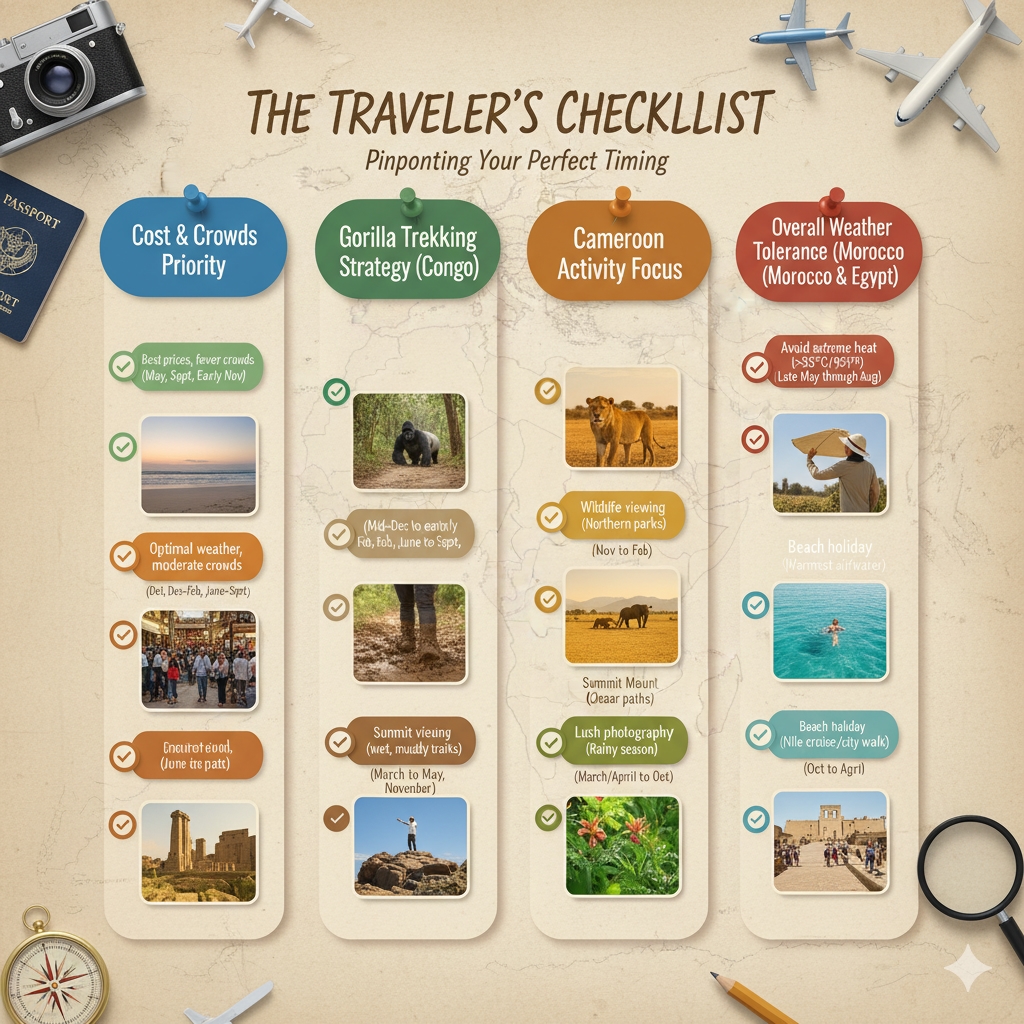
1. Cost & Crowds Priority
I want the best prices, don't mind a little heat/humidity, and prefer fewer crowds. (Focus on shoulder/low season: May, Sept, Early Nov)
I want optimal weather and activities, and I'm prepared to pay peak-season prices and deal with moderate crowds. (Focus on peak dry season: Oct, Dec–Feb, June–Sept)
2. Gorilla Trekking Strategy (Congo)
My absolute priority is the easiest trek (firm trails, less mud), even if I pay more for the permit. (Go during Dry Season: Mid-Dec to early Feb, or June to Sept)
My absolute priority is saving money on the permit, and I can handle wet, muddy trails. (Go during Wet Season: March to May, or November)
3. Cameroon Activity Focus
I want to maximize wildlife viewing in the northern parks and have the most reliable road access. (Go during Dry Season: November to February)
I want to summit Mount Cameroon with the clearest skies and driest paths. (Go during Peak Hiking Season: December or January)
I prioritize lush, green photography, botany, and low-season discounts in the south, even with heavy rain. (Go during Rainy Season: March/April to October)
4. Overall Weather Tolerance (Morocco & Egypt)
I cannot tolerate extreme heat above $35^\circ C$ ($95^\circ F$) for sightseeing. (Avoid Late May through August)
I am planning a beach holiday (Morocco/Red Sea) and want the absolute warmest air/water temperatures. (Focus on June to August)
I want the mildest, most comfortable weather for Nile cruising and city walking ($20^\circ C - 28^\circ C$). (Focus on October to April)
When Should I Schedule My Trip to Hit the Biggest Celebrations?
Timing your trip around a local festival can seriously level up your experience and give you an authentic glimpse into local life.
Morocco: Festival of the Roses (May, M’Goun Valley); Gnaoua World Music Festival (usually May/June, Essaouira) - Think spiritual, vibrant music on the coast.
Cameroon: Ngondo Festival (December, Douala) - A fascinating traditional water-spirit celebration.
Egypt: Abu Simbel Sun Festival (February 22 and October 22) - A truly ancient, must-see sun alignment event.
Islamic Holidays: Remember that Ramadan and Eid al-Fitr shift each year. Traveling during Ramadan is a unique cultural experience, but just know that many restaurants and services operate on reduced hours during the day.
Conclusion
Ultimately, the best time for your 2025 African mega-trip depends entirely on what you want to achieve. If history and culture are calling, aim for the comfortable weather between October and April in Morocco and Egypt. If wildlife and intense hiking are your goals, you'll need to schedule Cameroon and the Congos during their respective dry seasons (typically December–February or June–September).But remember: aiming for those shoulder months of April and October is the simplest way to get that great blend of good weather and moderate crowds across all four incredible destinations. Happy planning!
